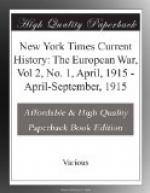At the end of the sitting the following resolution was unanimously adopted:
The Duma, saluting the glorious exploits of our soldiers, sends to the Russian Army and Navy a cordial greeting and to our allies an expression of sincere esteem and sympathy. It expresses its firm conviction that the great national and liberating objects of the present war will be achieved, and declares the inflexible determination of the Russian Nation to carry on the war until conditions shall have been imposed on the enemy assuring the peace of Europe and the restoration of right and justice.
TO THE VICTORS BELONG THE SPOILS!
By MADELEINE LUCETTE RYLEY.
[From King Albert’s Book.]
The Victor true is he who
conquers fear,
Who knows no time save now—no
place but here.
Who counts no cost—who
only plays the game.
To him shall go the prize—Immortal
Fame!
To the illustrious ruler and his gallant little nation, whose heroism and bravery are surely unparalleled in the whole of our world’s history, I bow my head in respectful homage.
Lessons of the War to March Ninth
By Charles W. Eliot
President Emeritus of Harvard University.
CAMBRIDGE, Mass., March 9, 1915.
To the Editor of The New York Times:
The observant world has now had ample opportunity to establish certain conclusions about the new kind of war and its availability as means of adjusting satisfactorily international relations; and it seems desirable in the interest of durable peace in Europe that those conclusions should be accurately stated and kept in public view.
In the first place, the destructiveness of war waged on the scale and with the intensity which conscript armies, the new means of transportation and communication, the new artillery, the aeroplanes, the high explosives, and the continuity of the fighting on battle fronts of unexampled length, by night as well as by day, and in stormy and wintry as well as moderate weather, make possible, has proved to be beyond all power of computation, and could not have been imagined in advance. Never before has there been any approach to the vast killing and crippling of men, the destruction of all sorts of man’s structures—buildings, bridges, viaducts, vessels, and docks—and the physical ruin of countless women and children. On the seas vessels and cargoes are sunk, instead of being carried into port as formerly.
Through the ravaging of immense areas of crop-producing lands, the driving away of the people that lived on them, and the dislocation of commerce, the food supplies for millions of non-combatants are so reduced that the rising generation in several countries is impaired on a scale never approached in any previous war.
In any country which becomes the seat of war an immense destruction of fixed capital is wrought; and at the same time the quick capital of all the combatants, accumulated during generations, is thrown into the furnace of war and consumed unproductively.




